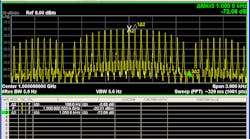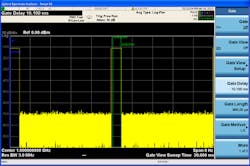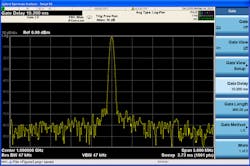This file type includes high resolution graphics and schematics when applicable.
Most modern spectrum analyzers have at least one method for making a time-gated measurement of the signal spectrum. The purpose of time-gated spectrum analysis is to measure the spectrum of a periodic signal during a specific portion of time. An example is to observe the spectrum of a pulsed signal only during the time that the pulse is on—not during the transitional or off periods of the burst. (In many cases, the spectral components that contribute to the pulse’s rising and falling edge will mask spectral components that contribute to the pulse’s on time.) Gating is also useful for measuring channel power, adjacent channel power, and spectral emission mask measurements of a modulated signal that is bursted in the time domain.
Time gating on these signals can often be challenging. Issues like narrow pulse widths, wide bandwidth signals, and lack of convenient gate triggers can make time gating difficult. This article examines a signal that is pulsed in the time domain. It then performs a time-gated measurement on that signal. As a result, it is possible to investigate the different types of time gating that are available and what applications are most appropriate for which methods. Gate triggering will also be examined, as well as measuring wide-bandwidth signals.
The Frequency Spectrum of a Pulsed Signal
The frequency spectrum of a pulsed continuous-wave (CW) signal can be determined very accurately by knowing the pulse width and period of the signal in the time domain. The spectrum of a CW pulse is a carrier with an infinite number of sidebands. The spectral components of the sidebands are spaced at 1/Τ, where Τ is the signal’s pulse period. The envelope of the spectral components is sinc (Δτ /T). The main lobe width is 2/τ and the spacing from the carrier to the first null is 1/τ. The duty cycle (DC) of the pulse is given by τ/T. This term is important, as it permits carrier amplitude to be determined when pulse modulated is 20log(DC) of the unmodulated carrier.
Figure 1 is a pulsed CW signal with a carrier frequency of 1 GHz and a peak amplitude of 0 dBm. The pulse width of the signal, τ, is 1 ms and the period of the signal, T, is 10 ms. The sidebands are spaced by 100 Hz or 1/T. The first null is 1 kHz above and below the carrier. The amplitude of the carrier is -20 dBm or 20log(0.1) dB below the unmodulated carrier.
1. Shown is the frequency spectrum of a CW pulse signal.
In practice, it would be difficult to determine the spectral purity of the pulse, as there are an infinite number of sidebands spaced at 100 Hz. Any one of these sidebands could be masking an unwanted modulation component or spurious signal. Here, time gating on the pulse can allow designers to observe and measure the spectrum of the signal only during the time that the pulse is on—in doing so, eliminating the spectral components that are present due to the rise, fall, and off time of the pulse.
Time Gating on a Pulsed CW Signal
Many analyzers now include features that assist with time gating on a signal. Figure 2 shows the gate-view setup screen for the X-Series signal analyzers. This feature allows the user to manually set the appropriate gate delay and length on the portion of the pulse that is of most interest. This interval is known as the “gate.” In the example, the time that the pulse is on is what is being viewed. Care is taken so that the rising and falling edges of the burst are not captured in the gate. The resolution bandwidth (RBW) used in the gate setup utility is close to the same that will be used when measuring the spectrum. An external trigger input is used as a gate trigger to synchronize the gate with the selected portion of the CW pulse being measured.
2. Using features like the one shown here, today’s spectrum analyzers allow users to easily set up a time-gated measurement.
The spectrum observed with time gating activated is the CW signal. The pulse modulation that is applied to the signal has effectively been removed (Fig. 3). As a result, it is possible to determine if there are unwanted spurious signals present on the pulse, which would otherwise be masked by the closely spaced sidebands described previously. In many cases, it may be a good idea to observe the spectrum—due to the transitory nature of the pulse—by gating on the rising and falling edges of the pulse. This can be done simply by changing the delay and length of the gate.
3. Time gating is performed on a CW pulse.
How Time Gating Works
There are several time-gating methods. In the previous example, time gating was performed by the LO gating method. It allows the spectrum analyzer to only sweep during the time interval of the gate. This approach has many advantages over other time-gating methods. For example, one can freely change many—if not all—of the spectrum-analyzer settings, such as detector type, resolution bandwidth, and video bandwidths. (In some cases, changing the RBW significantly from the setting used in the gate setup utility may require that these parameters be reset.)
Another common method for time gating in spectrum analysis is the gated video method, which gates the detected video signal that is displayed in the trace. Because the instrument sweeps are not synchronized with the gate trigger, one must ensure that each trace point on the display has sufficient time for the burst to be captured. This will normally require a much longer sweep time than LO gating. It also demands the use of a peak detector.
Vector signal analyzers normally use a Fast Fourier Transformer (FFT) gating method. Here, the gate window is captured in the time domain and an FFT is performed to display the spectrum in the frequency domain. FFT gating is also available for signal analyzers that have an FFT sweep capability. In the latter case, FFT gating is normally used for optimizing sweep times for signals with a narrow pulse width and a relatively long pulse period.
There are practical limits to how narrow the gate width and, therefore, a pulse width can be and still have time gating applied. The specification guide for the spectrum analyzer should contain this information.
Gate Triggering
In the past, time gating was only achievable if the device provided an external trigger or an external burst carrier trigger provided this gate trigger signal. In most modern spectrum analyzers, additional gate trigger methods are available. The most commonly used is the RF burst gate trigger. This trigger is generated by a rising or falling edge of a bursted signal, which is captured in the spectrum analyzer’s intermediate frequency (IF). This approach works very well for frequency spans that are less than the bandwidth of the spectrum analyzer’s IF.
An alternative is a periodic timer gate trigger. It can be used for time gating on a wide-bandwidth signal, which has bandwidth greater than the IF bandwidth of the spectrum analyzer when no external gate trigger is available. This trigger is generated automatically in the instrument at a specified time interval. The spectrum analyzer synchronizes the periodic time at the instrument’s center frequency between each of the sweeps. In doing so, it ensures that the periodic timer does not drift out of synch with the signal to be measured.
Time gating can be used with many built-in power-measurement functions, such as channel power (CHP), adjacent channel power (ACP), and spectral emissions mask (SEM). Figure 4 is a SEM measurement of an 80-MHz-wide IEEE 802.11ac signal. Because the periodic time is used as the gate source, no external trigger from the device is needed.
4. Pictured is a measurement of an IEEE 802.11ac spectral-emissions mask.
In older spectrum analyzers, time gating in spectrum analysis was very challenging. With gate utilities like gate view, however, modern spectrum analyzers allow users to easily set up a time-gated measurement. The new methods also resolve a lot of the issues that prevented time gating, as many devices did not have a convenient trigger available for the gate trigger.





